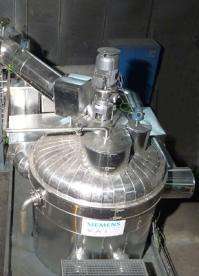Power from waste heat cuts costs and emissions

A new development from Siemens makes it possible for operators of electric arc furnaces to obtain electricity from hot exhaust gases. Around 20 percent of the electricity required to melt steel scrap could be recovered with the method, according to a report in the latest issue of the research magazine "Pictures of the Future". Up until now, it has been very difficult to carry out such a process because of temperature and gas-volume fluctuations. Siemens therefore developed a salt storage unit that acts as an energy buffer between a steel furnace and a turbine. The first pilot facility for the system went into operation in the German state of Thuringia in mid-April 2012; the first system product is scheduled to be manufactured in 2013.
Electric arc furnaces melt steel scrap under arcs heated with high-voltage electricity to a temperature of approximately 3,500 degrees Celsius. Such a unit requires around 370 kilowatt-hours of energy per ton of steel produced. The exhaust gases generated in the process can get as hot as 1,700 degrees Celsius. Previously attempted approaches for generating electricity from the gases failed due to fluctuations in gas temperatures and volumes, as steam turbines require a continual flow of steam in a very narrow range of temperatures.
The solution here was taken from the solar-thermal sector - more specifically from Siemens VAI Metals, which uses salt storage units like those employed in such power plants. Here, experts extract heat from the exhaust gas and the salt mixture heats up to around 450 degrees Celsius. Water flows through the hot salt and the resulting steam is used to drive a turbine. The high salt temperature gives the process an efficiency rating of 24 percent, which is greater than that of the second possible option for generating electricity in electric arc furnaces. In this alternative option, steam is produced from the exhaust gas and then stored temporarily in pressurized boilers. However, salt storage units are not only cheaper than such boilers but also safer to operate.
The new solution recovers around 20 percent of the electricity used to run the furnace, which means it also lowers carbon dioxide (CO2) emissions - according to the power mix - by approximately 40 kilograms per ton of steel produced. Given a typical furnace capacity of 120 tons, this results in an annual CO2 reduction of around 30,000 tons. That, in turn, translates into up to five million euros in plant operator savings on electricity and CO2 certificates per year.
Source: Siemens



















